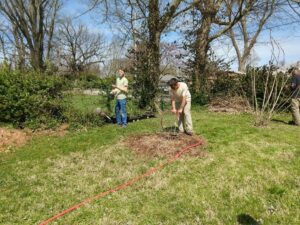Final report for FNC18-1147
Project Information
The project site did not have any crops or plants growing. No sustainable practices were used on the site.
Living compost and compost teas are integral parts of organic farming. The large populations of beneficial bacteria, nematodes, fungi, and protozoa found in compost can correct deficiencies in the soil food web, create healthy and fertile soil, and act as an organic/natural pesticide. Compost is a sustainable method for erosion control, plant health, land and stream reclamation, and environmental remediation.
Living compost containing beneficial microbiology is not commercially available in Southwest Missouri and represents a large gap in our community’s ability to create healthy soil, regenerate our ecosystems, and engage in sustainable, organic agriculture best practices. Composting best practices require training to identify and create optimal soil microbe ratios for use in crops and permaculture systems. This project provided extensive training on the soil food web, thermophilic compost creation, actively aerated compost tea creation, and using the microscope on the farm. The education and training to Southwest Missouri farmers and at-risk youth was the most inspiring portion of this project. Many workshops and trainings were help to teach attendees to develop small scale replicable compost and actively aerated compost tea systems with measurable microbe health using demonstrated best practices. The farmers used the highly successful train-the-trainer model developed by Springfield Community Gardens through a National Association of Conservation Districts grant. The workshops included education on soil health and creation of thermophilic compost and actively aerated compost tea systems as well as utilizing the microscope on the farm. In conjunction with the project, an abandoned urban lot in an impoverished neighborhood was planting with a young food forest and urban orchard and will serve the community as an education hub for the soil food web for many years to come.
At the conclusion of this research program, the abandoned urban lot remediation is well underway, providing a food forest with trees and shrubs that are growing to benefit this neighborhood and it's at-risk population. Actively Aerated Compost Tea was applied to the site to provide beneficial growth for the plants there and to teach the community the importance of soil health in growing conditions. Overall it seems that the actively aerated compost tea has been beneficial to the perennial plant species. The microscope assessment of the soil before and after shows us that the soil food web is improving and the trees sprayed trees seemed to be healthier than their unsprayed counterparts. More work needs to be done in increasing the diversity of soil food web organisms with other methods of soil regeneration including cover crops, native plantings, and building soil structure.
Several workshops were conducted, allowing at-risk community members and community based farmers to learn the specifics regarding soil conditions, soil health, use of compost in planting, and use of a microscope to study soil health, among other things. The farmers taught the same workshop series 3 more times and the workshop were full. Over seventy gardeners, farmers, and community members were reached with the information and future workshops are being planned to reach further in the community.
- Develop an economical and replicable small farm process for compost and compost tea recipes with optimal soil health for plant disease.
- Create positive environmental impacts and a strong foundation for a resilient inter-generational food system by increasing soil life and resiliency.
- Empower and educate the community with practical tools to positively transform the environment and local food production using soil science and regenerative agriculture.
- Build on previous collaborative efforts of individuals and organizations in the community who are skilled at implementing and teaching sustainable agriculture and conservation methods.
Cooperators
- (Educator)
Research
Initial Soil Sampling
The initial step was to obtain biological soil samples at the abandoned urban lot in Southwest Missouri chosen as the project site. Understanding the current status of the soil and the microorganisms missing from the current soil food web required a soil analysis. This soil analysis would provide details on what optimal soil microbe ratios are required in the perennial system. After the missing biological components are identified, compost that will add those microorganisms back into the soil ecosystem to benefit the perennial shrubs and trees will be added to the site. The process of obtaining a soil sample was initiated shortly after the reception of the grant.
In order to collect a biological soil sample representative of the overall soil at the project site, a through analysis of the land was completed, including identifying current crops or vegetation and assessment of the soil. A base map of the site was produced and a site assessment was conducted based on Elaine Ingham's research on soil microbes and soil analysis. The 25’ x 50’ testing area encompassed three different elevation points and was located in the middle of the lot near a mature tree (which in theory would have a fungal dominated microbiology). Soil core samples of 3 inches deep and 1 inch wide using a professional soil corer (Figure 1) were taken in three central locations on the property and followed Ingham’s methods (Figure 2). The contours on site were also mapped to ensure each sample was approximately at the same elevation but randomly selected on that elevation.
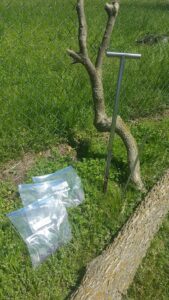
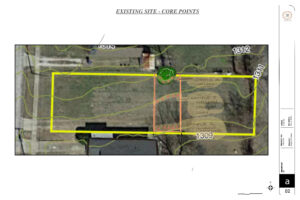
Soil Sample A was at the highest point and included a combined five soil samples taken between the drip line and the trunk of the tree (Figure 3). Plants near this core sample included a mature Hackberry and white clover. Due to our understanding of the history of the land, it is believed that herbicides had been used on the northern fence line in an attempt to control "winter creeper" by the City of Springfield (who owned the lot previously).
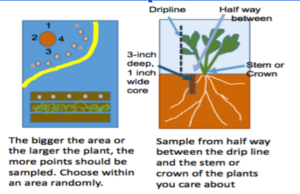
Soil Sample B was taken in the middle of the site and was dominated by crabgrass, white clover, and dandelions. We took core samples at the roots of these plants, half-way between the drip line and the stem (see figure 3).
Soil Sample C was lowest in the landscape. Mostly crabgrass was growing in this area.
After the samples were collected they were placed in sealable sandwich bags, labeled with indelible ink on the outside of the bags (date, plants around, notes) and shipped via FEDEX overnight to the Environment Celebration Institute Inc. soil lab.
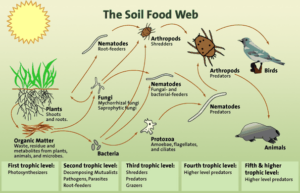
Perennial Tree Plan
The following trees were planted at the project site on December 15, 2018.
1) Pear varieties: Korean Giant Pear, Shinko Asian Pear; 2) Apple varieties: Williams Pride Apple, Staymen Winsap Apple, Arkansas Black Standard, Pristine, Enterprise, Royal Lumbertwig; 3) Illinois Everbearing Mulberry; 4) Juneberry; 5) Persimmon varieties: Saijo Persimmon, Nikitskaya Bordovaya Persimmon, Zima khurma =NB-02 Persimmon, Rossenyanka Persimmon; 6) Jujube varieties: Sugar Cane Jujube, Lang Jujube, So Contoured Jujube.
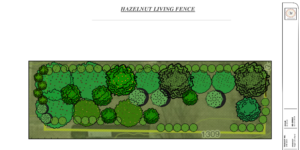
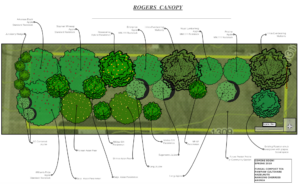
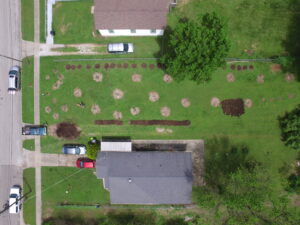
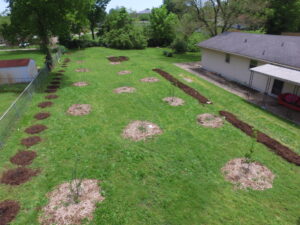
Initial Soil Analysis
Soil Sample A was at the highest elevation and had a number of plants growing nearby and is thought to have previously experienced regular weed control application. The soil analysis from this location had a very high amount of bacteria and ciliates (anaerobic protozoa) which indicate highly compacted and anaerobic soils.
Soil Sample B was taken in the middle of the site and was dominated by crabgrass, white clover, and dandelions. This sample had a very high amount of bacteria and ciliates (anaerobic protozoa), which indicate highly compacted and anaerobic soils.
Soil Sample C was lowest in the landscape. The tests revealed a high amount of bacteria but no ciliates were documented.
The soil analysis provided by the lab identified the need for perennial trees and shrubs, a diverse array of fungi, protozoa (flagellates amoeba both zero), nematodes, and predatory nematodes. The results identified the three soil core samples to be highly bacteria dominant and contained an elevated concentration of anaerobic ciliates protozoa (excluding sample C) with an acutely limited diversity in organisms. In essence, the soil test showed that the land at this location requires a biological system with fungal domination for tree production.
Compost Preparation
According to research by Elaine Ingham, 1 to 10 tons per acre of solid compost per application, depending on the organisms in the soil and in the compost, is required for successful incorporation of compost and fungal food into the soil. For compost tea or extract, 1 to 5 to 20 gallons per acre per application (depending on organisms) is required in the Spring and Fall seasons. Since the project site is .22 acres, we plan to use 5 gallons for the compost tea and extract.
This project attempted to developed a highly fungal dominated thermal compost and fungal vermicompost and added fungal foods to the compost tea. The thermal compost consists of 10% Nitrogen (food scraps, chicken waste, leguminous plants), 60% fungal foods (browns- leaves, diverse array of different hardwood and softwood species mulch, cardboard, and papers), and 30% bacterial foods (greens- grass clippings, plant material without seeds). The compost was created using Ingham's method of creating a round compost bin made out of tight welded wire and turning the pile when the temperature got to 131 degrees F. The farmers attempted to maintain a moisture content around 50% for the compost and used a three foot (3') stainless steel compost thermometer to monitor the temperature. A piece of metal "roof" was added to the top of the bin to maintain moisture levels and not let rain get into the compost pile. We learned the constant turning of these piles can kill the fungi we were attempting to grow and the microscope monitoring confirmed this. We decided to include a more diverse selection of compost from static compost piles and vermicompost to get a more fungal element for the tea. The quality of the compost is everything and the biology of the compost defines the quality. It was made clear from the trainings we took that ALL of the soil food web characters need to be present in the compost if we were to have successful compost tea and the verification with the microscope is an essential step to achieving this.
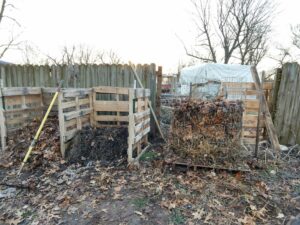
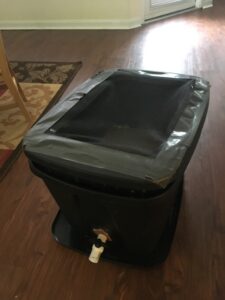
The compost was monitored through microscope viewing of samples regularly until the established date of the compost tea spraying. This grant allowed for the purchase of four brewing bucket kits which allowed multiple farmers to participate in the learning and experimental process and the microscope to allow the farmers to become familiar with the soil microorganisms present in the compost and actively aerated compost tea. The brewing buckets were raffled off to participants in the workshops along with compost starter, 400 micron mesh bags, and humid acid.
The project leaders utilized the assistance with local compost creation and expert help of Troy Hinke, of Living Roots Compost Tea, to ensure diversity in the compost used in the tea to include as many microorganisms as possible. Troy assisted in developing the powerpoint and helped lead the education and implementation portion of the workshop. Thermophilic compost and Vermicompost made from worm castings from the project leaders personal compost batches were all used in the final compost recipe for the tea. All composts collected were verified with the microscope to have most aerobic soil food web characters present.
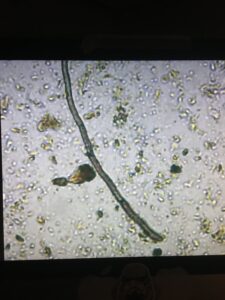
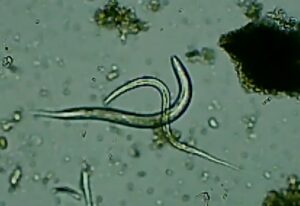
The project leaders and farmers learned the importance of the weather/temperature , the size of the brewer, supplying a constant supply of oxygen, and each miniscule piece of the brewing process was extremely important to the outcome of the tea, as they tested and reviewed samples of each tea under the microscope. Most videos and guides on the internet for the creation of AACT never mention the microscope and we have learned that this process is very scientific and the method must be followed and monitored.

BREWING OVERVIEW AND PROCESS
For the review of other farmers and those within the community who may be interested in replicating, we will include here a detailed review of the final brewing process. The Actively Aerated Compost Tea (AACT) that resulted from this brewing process was used on the Rogers Site (and the Page Project site) to inoculate the soil with beneficial organisms to encourage growth of the species of trees, shrubs, and other perennials that were planted at the Rogers Site during the community planting day. The Page Project had the same spraying regiment for the actively aerated compost tea on established fruit trees.
Two different teas were brewed, one which was a 55 gallon drum with a 2000 Gallons per hour commercial air pump. This was facilitated and led by the farmers and a recruited seasoned compost brewer who had the commercial equipment to efficiently provide an on site demonstration for the size of the Rogers lot as we learned the 5 gallon bucket method would have worked but would have taken much more time and energy. This tea was brewed on site using thermophilic compost and vermicompost. This particular batch of tea was sprayed on half of the crops at the Rogers Test Site using both a commercial root feeder (similar to Greene Garde Root Feeder) and commercial spray gun (similar to a JD-9C Gun) which was attached to a Honda WX10 water pump that allowed the compost to be applied. The water pump allows the microorganisms to be sprayed without being chopped up by a pump and the large diameter tubing allows the tea to move freely without clogging. A lot of research went into the types of pumps to use for compost tea and the information can be overwhelming. The pump chosen was the trash pump and the water pump for this type of scale. Other pumps are available including diaphragm pumps and centrifugal pumps but most of the research we found shows that the organisms may die when put through the pump. The root feeder allowed the farmers to apply the soil microorganisms directly to the rhizorsphere or the direct root zone of the trees. A foliar spray on half the trees was applied with the commercial spray gun and to the existing groundcover near test plots A, B, and C. The plants in the test plots where sprayed with the tea in the roots and a foliar spray while their counterpart of the same species and rootstock were not.
The second tea was a five gallon brew using the TeaLab 5 gallon bucket setup. The the project leaders brewed, transported, and kept the water aerated the entire time to the site using an inverter in the vehicle to keep the oxygen to the compost flowing (no power at rogers site). This tea was applied with a solo backpack sprayer which clogged at the very end of spraying, a larger nozzle head or internal filter is needed to spray with such basic equipment but it did get the job done. All new plants were dipped in the AACT prior to planting to ensure root inoculation.
Both brewers used the same step by step process to brew the tea, differences dependent only on what size of brewer they used.
STEP ONE: WATER QUALITY & TEMPERATURE
Dechlorination of the Water: Project leaders used chorine test strips to test for water chlorination levels during the preparation of the water that was eventually used to make the tea. Humic acid was added to the water to begin the dechlorination process, the humic acid according to Ingham helps absorb the chroline. This technique was described in great detail in Elaine Ingham’s course and researchers decided that this was the most feasible and accessible way to complete this process.
However the dechlorination process was surprisingly challenging for the project leaders according to the testing strips to verify the presence of chlorine (which will kill microorganisms). Municipal water was used for both teas. The water was sat out over night and aerated the majority of that time to “off-gas” any chroline. The farmers tested every four hours for presence of chlorine and these amounts were recorded in research logs. Chlorine seemed to stick in the water for many more hours than the project leaders had anticipated and that Ingham had suggested in the online trainings. The water quality is critical for the health of the AACT and we have moved forward with using rainwater or well water for all future batches. The tea should be brewed outside at the same temperature that it is going to be applied.
During the process, the brewer is set up, the water is dechlorinated, and the water is being oxygenated and aerated with a bubbler or commercial air pump. Researchers made sure that there was high enough aeration so the surface of the water is bubbling very rapidly and that you visually have a "boiling effect".
Following this process, project leaders proceeded to step number two.
STEP TWO: ADD MICROORGANISM "FOODS"
The addition of foods or additives for the microorganisms to eat and grow is the next step. The foods are added first to dilute any preservatives or agents that were added to the foods. We let this sit for an hour before the addition of the actual compost. Project leaders chose the most appropriate compost foods for the Rogers site’s needs based on the initial soil tests conducted. Fish hydrolysate (not fish emulsion), kelp (salt free), steel cut oats, and humic acid (not from leonardite) were added to the brewer. No bacterial foods were added to the recipe as the initial lab results showed that our soils had an extreme excess of bacteria so we didn't need to grow those but were in need of predators to balance the bacteria population. A handful of straw was included to increase levels of protozoa (don't use straw contaminated with herbicide). *The amount of foods and recipe depends on the goals and size of brewer.
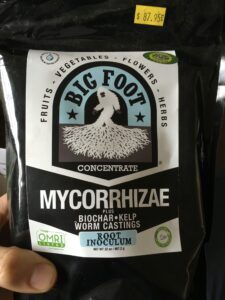
Recipe for the 5 gallon brew: 4 cups of living compost (mixture of thermo, static, and vermicompost), 1 tablespoon of fish hydrosolate, 1 tablespoon of liquid kelp, 1 tablespoon of steel cut oats. A handful of clean straw was added in the brew bag. 4 tablespoons of mycorrhizae inoculant was hand mixed in at the END of the brew after aeration (final step).
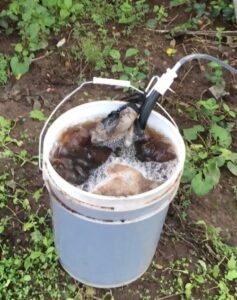
Recipe for 55 gallon brew: 16 cups of living compost (mixture of thermo, static, and vermicompost), 1/2 cup of fish hydrolysate, 1/2 cup of liquid kelp, 1/2 cup of steel cut oats. A handful of clean straw was added in the brew bag. 2 cups of mycorrhizae inoculant was hand mixed in at the END of the brew after aeration (final step).
STEP THREE:
Following the addition and processing of the compost foods (1 hour), the compost was added to the water. A special compost tea bag was included in the brewer kit and is a 400 micrometer nylon mesh bag; farmers learned that a paint mesh bag from any hardware store is compatible with this requirement. You want to be certain the size of the mesh allows any large soil food web characters (nematodes and fungi) to pass through the mesh and into the tea solution. Compost was selected from the finished compost pile that farmers began earlier in the grant timeframe. This compost was placed in the 400 micrometer mesh bag which was inserted into the prepared water above an commercial air pump and bubbler. Project leaders watched closely to ensure that the compost tea bag was being agitated correctly and that all portions of the tea were being aerated. *In hindsight, researchers stated they would prefer to have purchased an oxygen meter for this stage of the preparation to ensure that the compost tea remained above 6PPM oxygen and did not become anaerobic.
Let it brew.
STEP FOUR: BREWING TIMES & PROCESS
The "rule of thumb" for brew times is based on average temperatures between day and night. The colder the outside temperature the longer the brew; the warmer the outside temperature, the shorter the brew time. 50-65 degrees F= 72 hours, 66-80 degrees =48 hours. The batch was brewed around 70 degree weather and was brewed for 48 hours. Ingham suggests every 8 hours look under the microscope to verify that the brew has not gone anaerobic and that the organisms have not gone dormant. Researchers monitored the tea every 8 hours as suggested. The brew was allowed to brew for the full 48 hours and this allowed the organisms to have used up all of the foods that we added. When verifying with the microscope we wanted to see the organisms leveling out and according to Ingham that is when the tea is officially done brewing.
STEP 5: COMPOST TEA APPLICATION
Once project leaders were satisfied with the completed AACT they transported it to the Rogers Site (kept aerated with battery) where a group of 15 community participants, at risk youth, and local farmers were present and assisted in the application process. The AACT was transferred from a 55 gallon drum to a 250 IBC water tank that was 3/4 of the way full with dechlorinated water. The large batch was diluted to evenly spray across the entire site (the 5 gallon brew was sprayed at 100% concentration). This particular batch of tea was sprayed on half of the tree crops at the Rogers Test Site using both a commercial root feeder (similar to Greene Garde Root Feeder) and commercial spray gun (similar to a JD-9C Gun) which was attached to a Honda WX10 water pump that allowed the compost to be applied. The water pump allows the microorganisms to be sprayed without being chopped up by a pump and the large diameter tubing allows the tea to move freely without clogging. Again a 400 micrometer or larger nozzle is essential to getting the organisms applied to the soil or foliage. The same batch of tea was later applied to trees on the project leaders own farms to diversify the ability to measure effectiveness. The five gallon tea brew was applied using a solo sprayer on the Rogers Site and the project leaders site. The backpack sprayer was no where near as effective as the spray gun sprayer and clogged near the end of the application (the rest was hand watered in). The smaller Wayne trash pump purchased with the grant was used at Page Project site but the Honda WX10 was the most efficient and productive tool used to get compost tea out of the brew container and onto the plant or soil.
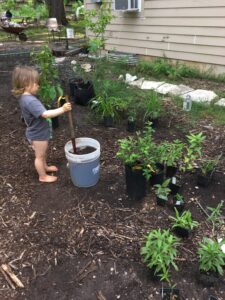
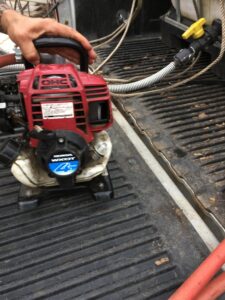
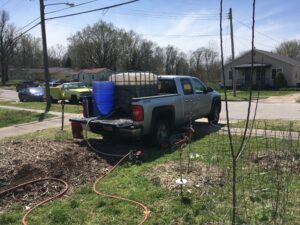

The compost tea applied was not as fungal as we would have hoped but was slightly more fungal dominant than bacteria. We still have much to learn about perfecting this process and utilizing other means to produce a large population of fungi for compost teas. We had this entire process open to to attendees during the workshop. Community participants were taught about use of the microscope and had a hands-on demonstration as this may be the most significant portion of making living soil, composts, and compost teas. The training also involved the use of the compost tea sprayer, specifics regarding the creation of a compost pile and the creation of compost tea, and soil testing and maintenance processes. The workshop then moved locations to the Rogers Site for an actual demonstration of the compost tea application process. The tea was finishing the brew process during the lecture portion and participants had the ability to see the brew process in action.
Participants were encouraged to return to the site at different times throughout the rest of the year to assist researchers in monitoring soil health and tree crop health.
MICROSCOPE PORTION (Link to Quantitative Microscope Assessment- Microscope SARE assessment Sheet1)
All samples observed with: 10:1 Dilution (10 parts water- 1 part soil), 18mm cover slips, 1' x3" cover slides, OMAX M8311 Trinocular Compound Microscope w/ Celestron 5MB Camera.
Qualitative Microscopic Assessment based on Elaine Ingham Methods (Direct Microscopy)
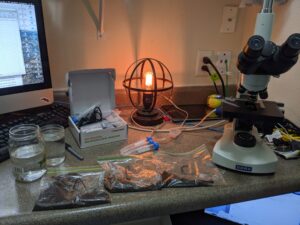
The initial soil analysis provided by the lab identified the need for perennial trees and shrubs, a diverse array of fungi, protozoa (flagellates amoeba both zero), nematodes, and predatory nematodes. The results identified the three soil core samples to be highly bacteria dominant and contained an elevated concentration of anaerobic ciliates protozoa (excluding sample C) with an acutely limited diversity in organisms. In essence, the soil test showed that the land at this location requires biological and fungal nutrients for tree production.
Biological Soil Analysis #2 Summary- October 2019
Soil Sample A (base of Illinois Everbearing Mulberry) The initial soil analysis from this sample (A) was high in bacteria, had a low fungi population, and a very high number of ciliates (10,726 μg). Farmers observed with the microscope that the population of bacteria hadn't changed that much with the first application of the actively aerated compost tea but a great majority of the soil food web characters were now present and beginning to balance out the bacteria population. The initial sample (A) had zero predatory microorganisms and after one application of tea an explosion of testate amoeba, flagellates, and bacteria feeding nematodes were measured on the site. While the fungal growth did grow slightly it was not significant and is not close to the threshold of a healthy fungal dominated system. The compost tea did not immediately change the conditions of the soil to be more fungal. The ciliate population did not change with the first application.
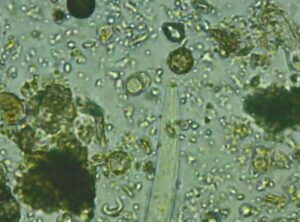
Soil Sample B (Base of Sugarcane Jujube) The sample was taken in the middle of the site and was dominated by crabgrass, white clover, and dandelions. This sample had a very high amount of bacteria and had no predatory or nutrient cycling microorganisms in the sample. The initial fungi population was decent and had a good base to begin. The fungi grew slightly since the initial sample and we have not seen a meaningful difference in the fungal growth that would cause us to say this was highly successful. Some large diameter fungi were identified. A major success is that predatory microorganisms were counted in the sample. Many flagellates were identified as well as testate amoeba, and two predatory nematodes were documented in the sample.
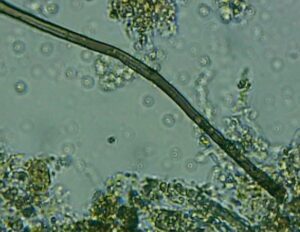
Soil Sample C (base of Nanking Cherry shrub) The sample was taken lowest in the landscape and was dominated by mostly crabgrass. The initial lab tests revealed a high amount of bacteria but no ciliates were documented. The sample still had a high amount of bacteria and very little amount of fungal growth. The initial sample and a F:B Ratio of 0.02 and it was document at 0.36 with this sample. The fungi actually dropped below the number of the last sample. A massive change in the amount of flagellates and amoeba were observed in the second sample which signifies that the bacteria population is beginning to be consumed. On top of that, bacterial feeding nematodes are now present at the roots and are cycling nutrients in the shrub. Ciliates were observed in the second sample that were not in the first.
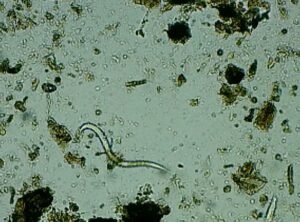
Biological Soil Analysis #3- February 16, 2020
Soil Sample A (Illinois Everbearing Mulberry) The bacteria population continues to drop as the predatory organisms stabilize. No ciliates were found in the sample which suggests that the aerobic protozoa are starting to dominate and the anaerobic conditions suitable for ciliates are becoming sparse. The count and images show that testate amoebae and flagellates continue to progress; so nutrient cycling is occurring and increasing. No bacteria, fungal feeding nematodes or predatory nematodes were observed so we still have some work to do to get more diversity into the soil ecosystem. The fungal population has not changed very much since the initial soil sample and the soil surrounding this plant is still a bacteria dominated soil. The fungal to bacteria ratio is currently 0.26 and started at 0.14.
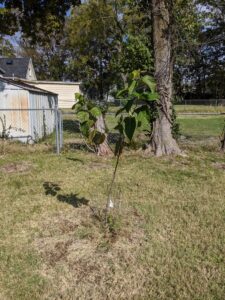
Soil Sample B (Sugarcane Jujube) The understory is still crabgrass, white clover, and dandelions. This sample still has a very high amount of bacteria compared to fungi. The fungal bacterial ratio had initial ratio of 0.22 and has only changed slightly to 0.34; the target ratio for shrubs and trees is around 5 and we are still no where close to that number. Again, the fungi has grown slightly since the initial sample and we have not seen a meaningful difference in the fungal growth that would cause us to say the fungal compost tea was highly successful. The count and images show that testate amoebae continue to progress but the flagellates number slightly decreases. Beneficial bacteria eating nematodes were identified in this sample which is encouraging for the bacteria population reduction.
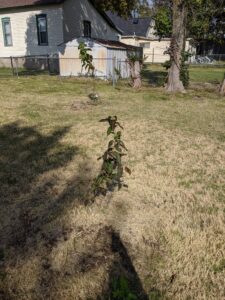
Soil Sample C (Nanking Cherry) Cover crops including Daikon Radish, White Clover, rapeseed, and chicory were seeded in the fall of 2019 to see if any difference would occur on top of compost tea sprays. This was added to see if having more roots emitting exudates would increase the foundation of life in the soil from the teas. The F:B ratio is still at 0.36 with this sample. However, the flagellates and amoeba have again grown and were in most of the slides. The bacteria population has also taken a significant drop in numbers and the the flagellates and testate amoeba grew significantly. Many bacterial feeding nematodes were observed in the slides as well with no ciliates in the sample. The cover crops seemed to make a significant addition to the amount of predators and nutrient cycling around the cherry. The vandalized Nanking cherry also may have released exudates when it was snapped releasing its energy into root production attracting more microorganisms.
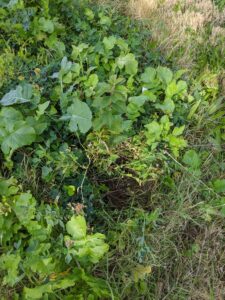
Soil samples were taken at varying stages of this process, including at the conclusion of the grant cycle. These samples were studied under the microscope purchased by the grant. At the conclusion of the grant cycle, project leaders were able to witness increases in beneficial organisms within the soil samples that had been sprayed with compost tea, while no increases were measured in the soil samples that had not been sprayed. This allows for the project leaders to make a case for the importance of compost tea application for getting beneficial microorganism into the soil and encourages farmers to use this application of compost in their own farms. The education and training on the use of the microscope has been extremely valuable to the farmers and the community. Compost tea may not be the savior that it is made out to be in recent times but it has acted as a catalyst to begin nurturing the soil food web on this abandoned lot. This doesn't seem to be the end of the story and the farmers will continue to implement other methods in conjunction with applications of actively aerated compost tea to foster the soil food web and tree crops.
Tree Observation & Vandalism
Project leaders recorded varying levels of vandalism at the community site to all portions of the testing area (Rogers Test Site) which made measurement of growth on the trees difficult to assess. A majority of the trees had been struck with an object leaving severe bark damage to the trunks of the small trees and a little less than half were snapped completely. While the goal of the project was pure neglect of the trees after establishment (mulch, tree cage, periodic mowing); the vandalism caused the farmers to administer some emergency pruning to ensure the trees survival.

The trees are still alive and root systems are still intact to be able to measure the microbial activity in the soil and that is the main assessment method besides the two juneberry plants that were an extra experiment (not in original research zone) that were not vandalized in any way. Two Juneberries were planted at the same elevation (NW Portion of site) and directly next to each other: Juneberry #1 had a spring and fall root injection, soil drench, and foliar spray while Juneberry #2 was completely neglected without any sprays or root injection.
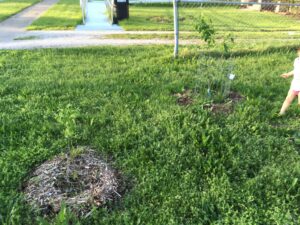
Juneberry #1 had lush green foliage all the way from Spring 2019 to Fall 2019 and grew erect shoots over four feet tall and had very little signs of disease or stress.
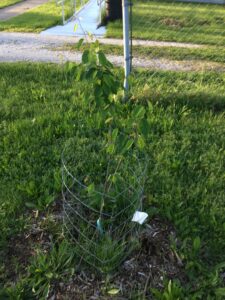
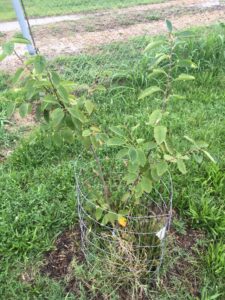
Juneberry #2 (No AACT) was visibly shorter and had a less growth in the Spring. The leaves were green and lush but began to diminish over summer. Juneberry #2 grew roughly 8-10" in the growing season and leaves began to turn yellow and eventually dropped off the tree showing visible signs of stress.
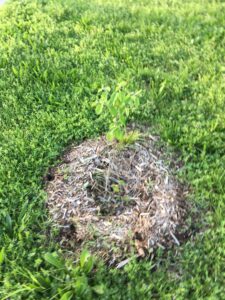
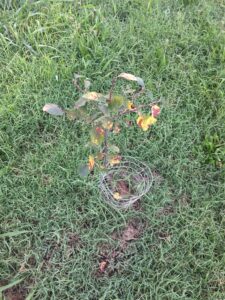
The simple observation between these two Juneberry plants does not tell the whole story with these trees but showed us that the Actively aerated compost tea was having a beneficial effect on the immune system of the plant and providing a less stressful environment.
Discussion on Next Steps
Due to the long term vision of this project, encapsulated in the idea of providing food bearing trees to a community for many years to come, it is essential that project leaders continue to monitor the site, add further rounds of compost tea, develop on the existing planting plan, and make amendments to the soil and the trees planted as necessary.
Project leaders feel that this two year project was very successful in that this grant and the other community wide funding and support allowed for such a long term project to begin and grow so extensively in such a short time. The information project leaders gleaned from the Life in the Soil Course by Elaine Ingham and delivered to the community created many new connections within the soil food web for numbers of community members as well as the project leaders themselves. This information will continue to be delivered to the community through future workshops and has already been integrated into the farming knowledge of numbers of people within the Ozarks area in a way that was not present prior to this project.
Educational & Outreach Activities
Participation Summary:
This project was widely advertised amongst Springfield Community Garden's (SCG's) large network of volunteers, donors and supporting community members, in addition to support provided by Tiffany Frey, Executive Director at the James River Basin Partnership. The social media campaign included information about the grant, available workshops and information gained as part of the Soil and Composting Classes.
A total of four workshops were conducted throughout the grant cycle. The workshops were advertised on social media posts on SCG's Facebook and Instagram pages as well as on the grant participants' personal blogs, social media and business pages. In addition, the workshop and grant project was publicized by SCG's staff at its board meetings and other events.
"The Relationship Between Soil & Water" by Tiffany Frey and Benjamin Tegeler - focused on the role water plays in agriculture and how unhealthy soil contributes to the loss of fresh groundwater that is essential for productive crops. Tiffany highlighted the importance of using restorative agriculture techniques, such as swales, hugelkultures, natural windbreaks, no-till/low-till practices and rain water harvesting to improve soil health. Ben Tegeler expanded on the foundation of soil health introduced in Tiffany's presentation by going in-depth into soil ecology, the soil food web and vital microorganisms. Ben's lecture outlined the difference between soil and dirt and provided a brief overview of the importance of the five levels of the soil food web, including the importance of maintaining appropriate levels of bacteria and fungi in soil.
"Compost Tea and Microscope Workshop" conducted by Benjamin Tegeler- This workshop was conducted during the second half of the grant cycle and more detail regarding the workshop preparation and execution is included in the compost tea section of this paper. Project leaders promoted this workshop through facebook posts on both Springfield Community Gardens’ page and Ozark Mountain Permaculture’s page. This workshop was well attended and many at risk populations were present during the learning component of the workshop which allowed the project leaders to communicate this information to a variety of subsections of the community.
In addition to the two workshops, a hands-on learning project in collaboration with Lucky's Market was provided during December 2018. The Community Food Forest Planting Day was a great success with over 27 community-members joining Ben Tegeler and team, SCG and Lucky's Market representatives for a tree planting and discussion of food forest design.
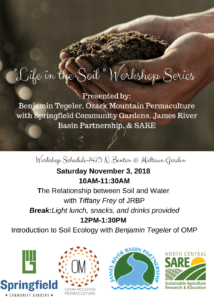
with Tiffany Frey
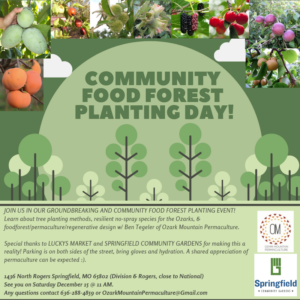

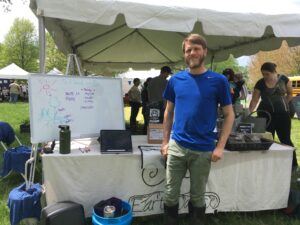
Learning Outcomes
Through the soil sample analysis and the Life in the Soils training, project leaders learned how to better explain to other farmers the need for a substantial perspective shift from a linear view of soil amendments as a general fix to a more comprehensive knowledge of the universe of microorganisms in the soil and the soil food web that sustains the land and crops produced. A partnership between farmer and the extensive living community of microorganisms in soil is required in order to rebuild the increasingly disused, nutrient deficient, and disease-burdened land in the area. The realization that small changes can have significant affects on the soil and crop production has been one of the most substantial current learning outcomes both for the project leaders and those attending the workshops.
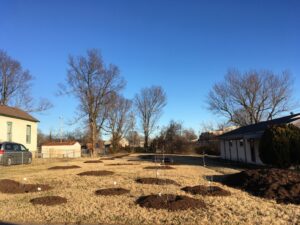
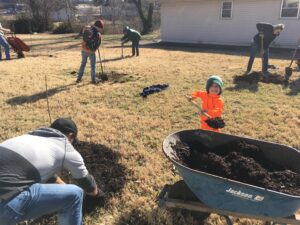
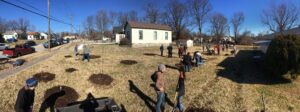
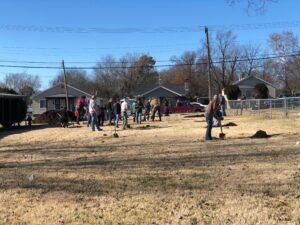
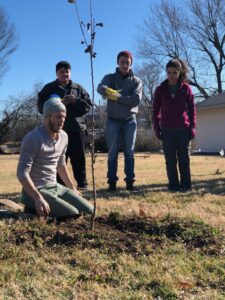
Project leaders learned a lot of information regarding the brewing and application of the compost tea during the preparation and execution of this workshop. There are several things that project leaders would do differently in future applications but overall the compost tea application and workshop was a success. The surrounding community is aware of a new tool for use in their own homes and farms and post surveys showed that each participant learned something new and would be interested in further information on these topics or similar topics in future workshops.
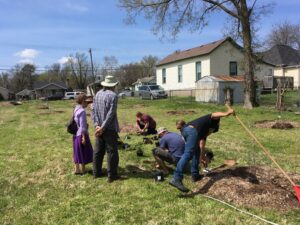
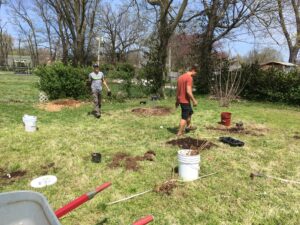
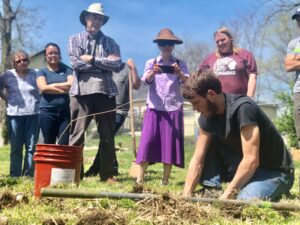
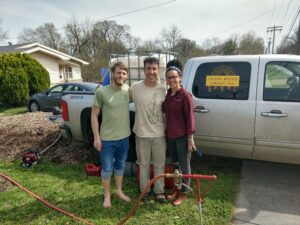

Future workshops are being scheduled to deliver this information to even more community members as many of the workshop components throughout the grant were filled and had waiting lists due to space and preference of project leaders for teaching skills.
Project Outcomes
“I attended both the Relationship Between Soil and Food Workshop and the Community Food Forest Planting. Being a college student on a fixed budget I was able to really appreciate both of these events for the fact that they were simultaneously educational, positively impacting the community, and free to the public. As an Environmental Biology major, these two events were great for me to attend, and helped give practical applications to much of what I’m being taught in a lecture hall. It was amazing to watch the community food forest come together, and the information presented throughout the event was extremely useful. Instruction was provided on designing food forests, regenerative food systems, and simply planting trees. The workshop on soil promoted creating a healthy, living soil that breathed. Understanding the soil web is crucial to this process and Ben Tegeler was able to explain in it a practical way that made sense to everyone, no matter their environment. I would love to attend more events like these and would encourage others too, as well.” - Student, Missouri State University, Springfield, MO
“As a student studying Environmental Biology, it was wonderful to expand my knowledge of the natural world, guided by passionate, experienced people. During “The Relationship Between Soil and Food Workshop,” I was able to gain insight into what truly happens beneath the soil, and how various microbial interactions drive the process of growing food filled with nutrients. I was shown the importance of living, aerobic, healthy soil, and the various ways of encouraging organic growth within the ground. Attending the Community Food Forest Planting Day proved to be an immersive look into the concepts covered at the soil workshop. I was able to apply the knowledge I had gained to build a thriving environment for healthy soil, and in turn, healthy plants which will feed the community. I am grateful to have this hands-on experience, and intend on using the concepts learned when conducting research in the future, as well as possibly building a regenerative food system of my own.” - Student, Springfield, MO
“It was really great to meet Ben, Rachael and Tiffany at the Life in the Soil workshop. This is not the first time I have been introduced to the soil food web and the soil textural triangle, however this was the first time I have been exposed to rebuilding soil based on microorganisms not focusing on solely NPK. Having the ability to form soil in a few months versus the commonly said hundreds of years is promising for the future. I am really looking forward to attending the compost workshop! “- Community Urban Gardener, Springfield, MO
"The value of the SARE composting project has been life changing. Because of the information that was given to me from the workshops I have gained knowledge that will help fulfill my non-profit, who's mission is to divert food-waste from the waste stream and provide composting education for the community. I have learned how the soil food web functions properly and how compost can help to heal the over worked soils. This information is life changing because it provides an answer for degenerative soils and the ever-haunting climate change dilemma. If we can put life (microorganism, fungi, protozoa, nematodes, anthropoids, etc.) back in the soils and allow for the soil to hold carbon again, we have a chance at reversing climate change. This provides a solution for every community member to be involved in. I have gained the knowledge for these solutions with the SARE compost grant.
I am the founder and executive director of Springfield Compost Collective and the experience I have gained through this grant will help to complete the mission of my non profit because it has connected me to community members, other non profits, and soil/compost experts that I can now call on when needed to form partnerships. This composting project has shown me how to correctly and most efficiently make life giving compost and compost tea that is full of beneficial bacteria and fungi. I am confident in my skills and knowledge to hold high level composting and soil health workshops for my community as well as travel to speak at conferences sharing the knowledge I have gained.
I plan to make the most beneficial compost I can for the community based on the knowledge and experienced gained from this information. I am currently working on applying the compost knowledge to Springfield Community Gardens' 18 garden locations along with scheduled thermal composting workshops in the Spring. I have successfully create 3 thermal composting piles and am currently working on a thermal composting project to create compost tea for unusable soil lots in hopes that next season life will be back in the soil food web and thriving.
This information has truly changed my life. I am extremely grateful for the opportunity to work with such intelligent people whose focus is on creating a regenerative community and restoring life back to the ground. I feel as if my life passion has been re-energized and I now know where I would like to focus my time and energy. Bringing awareness to the soil food web and providing life giving compost for my community is my life goal." - Regenerative Farming Business Owner, Springfield, MO
